2006 VOLKSWAGEN GOLF MK5 warning
[x] Cancel search: warningPage 111 of 444
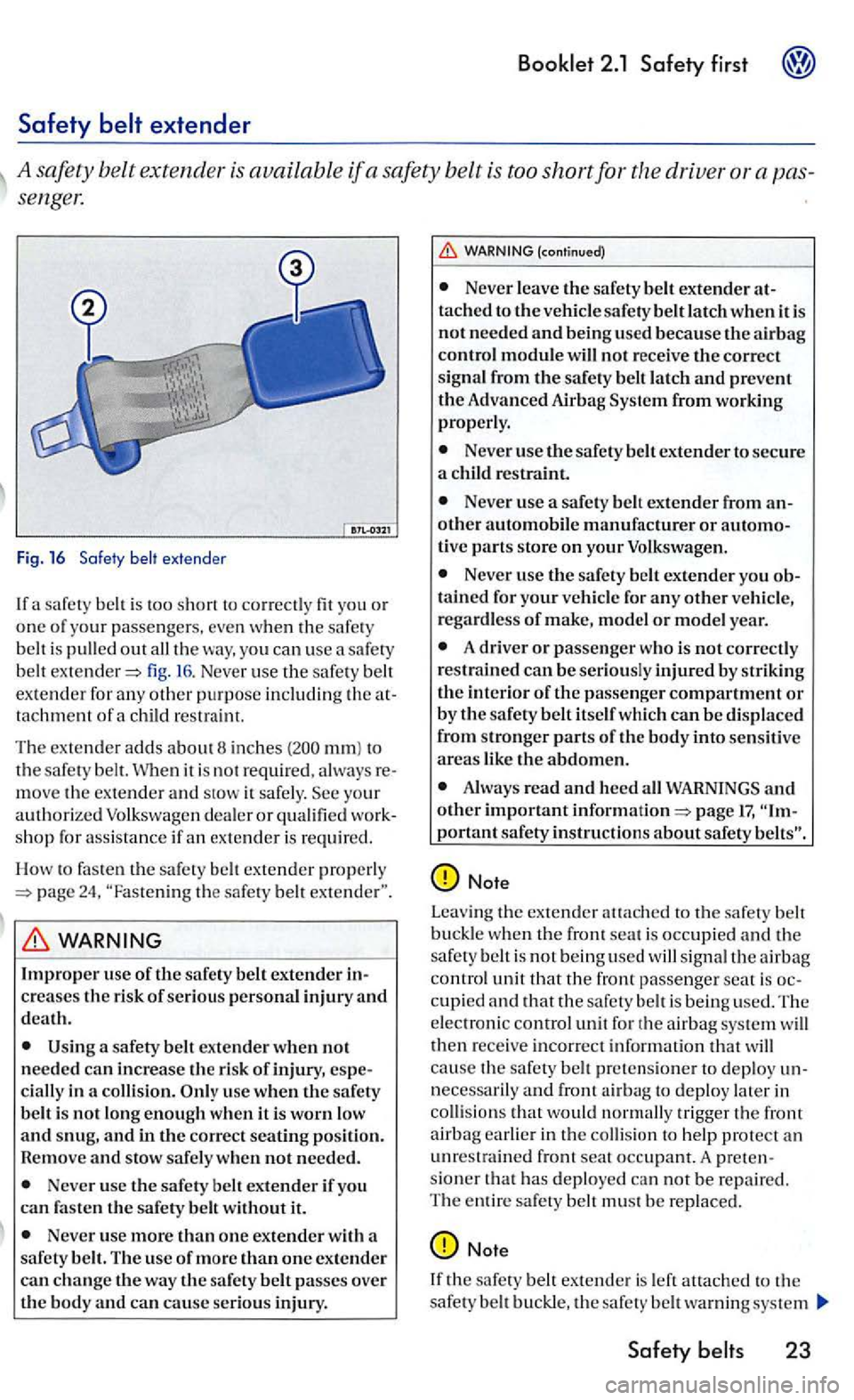
Safety
sengel:
Fig. 16 Safe ty
out fig . 16 . Never use th e safe ty belt
ex tende r for any oth er purpo se includin g th e tachment of a c hild restraint.
Th e
exte nder adds a boutB inches mm) to
the safery belt. Whe n it is not require d , always
s hop for a ss is tan ce if an extende r is requ ired .
H ow to fas te n the s
afety belt extender properly 24, th e sa fe ty belt
crea ses the risk of seriou s personal injury and death.
a safery belt exten de r w hen not needed can increase the risk of injury , cially in a collision. it is worn low
and snug, and in the cor rec t seating position.
R emove and sto w safe ly when not needed.
Never use the safet y belt extender if yo u
ca n fasten the sa fety belt without it.
Never use more than one extender with a
safery be lt. The use of m ore than one extender c a n ch ang e the way the sa fe ty belt passes over
the body and can cause se rious injury .
Never leave the saferybelt extender ta ched to the veh icle safe ty belt latch when it is not needed and being used because th e airbag control module will not re ceive the correc t
s ign al from the safety b elt la tc h and prevent the Advanc ed Airbag from working properly .
Never use the safe ty belt extender to secure
a child restraint.
Never use a safery belt ex tender from
Nev er u se the safery belt extend er yo u tained for your vehicle for any other vehicle,
regardless of make, model or model year.
A driver or pass enger w ho is not correct ly
re strained can be seriously injured b y striki ng the interior of the passe ng er compartment or by the safery b elt its elf whi ch can b e di spla ced
from stronger parts of the body into se nsiti ve areas lik e th e abdomen.
Always read and heed all WARNINGS and other important pa ge
signal th e airbag
co ntrol unit that the front passenge r seat is
ca use the s afery belt prete nsio n er to deploy necessarily and fron t to deplo y la ter in
collision s th at would trigge r the front
a irb ag earlie r in th e to help pro tect an unrestrain ed front seat occ upant. A sioner that has dep loyed can not b e repair ed.
T he entire sa fety belt mu st b e rep laced.
Safety
Page 112 of 444
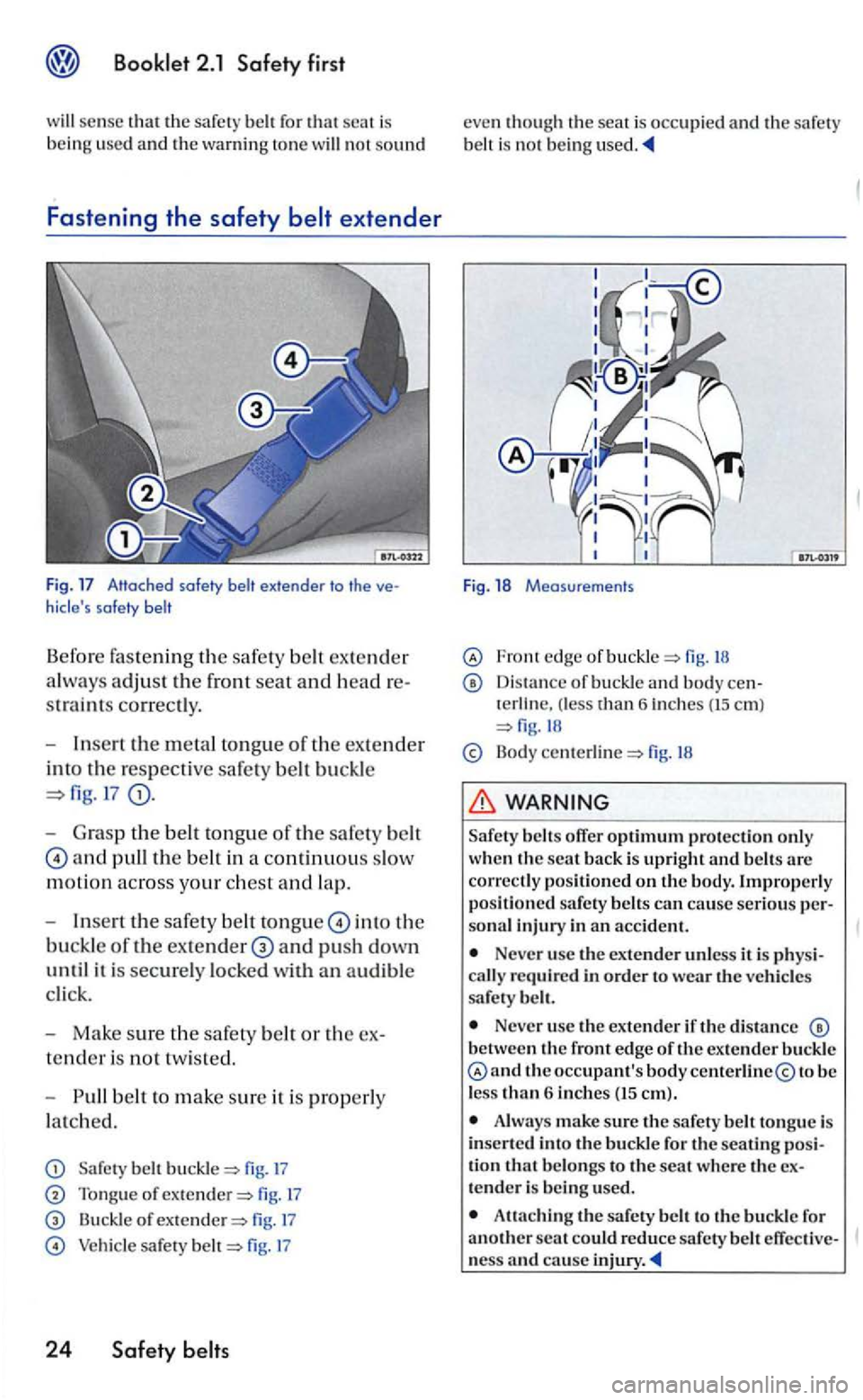
used and the warnin g to ne will no t sound
Fastening the safety
extender to the hide's safety belt
B efor e fastening th e sa fe ty ex tender
a lwa ys adjust th e front seat and hea d str aint s correctly.
- In
sert the m etal ton gu e of th e ex tender
into th e res pectiv e safety belt buckle
- Gra sp th e belt tongue of th e s afet y belt
and pull the belt in a continuous s low
motion across you r chest and la p .
- Inse
rt the safe ty belt ton gue into the
buckle of th e ex tender and push down
until it is secure ly lo cke d with an audibl e
cli ck.
- Make s
ure th e safe ty belt or th e
tender is no t tw is ted.
-
Sa fe ty belt buc kle fig . 17
Ton g ue of ex te nder fig. 17
Buckle o f ex te nd er fig. 17
fig. 17
24 Safety
ev en th oug h the seat is occupied and the safety
belt is no t being used.
Fig. 18 Measurements
Fro nt edge of buckle fig. 18
Distanc e of buckle and body (les s than 6 inches (15 em ) fig.
Body centerlin e
WARNING
belt s offer optimum protection only
when scat back is upright and b e lts are correctly positioned on body. Improperly
po sition ed safety belts can cause serio us
u se the extender unless it is ca lly required
Never use the extend er if the distan ce betwee n the front edge of the ex tende r buck le th e occupant's body centerlin e@ to be l ess than 6 inches (15 em).
A lwa ys make sure safety belt tongu e is
insert e d into the buckl e for the seating tion that belongs to the seat wh ere the tende r is being used.
Attaching t11e sa fety be lt to the buckle for
ano ther seat could reduce safe ty belt ness injury.
Page 113 of 444
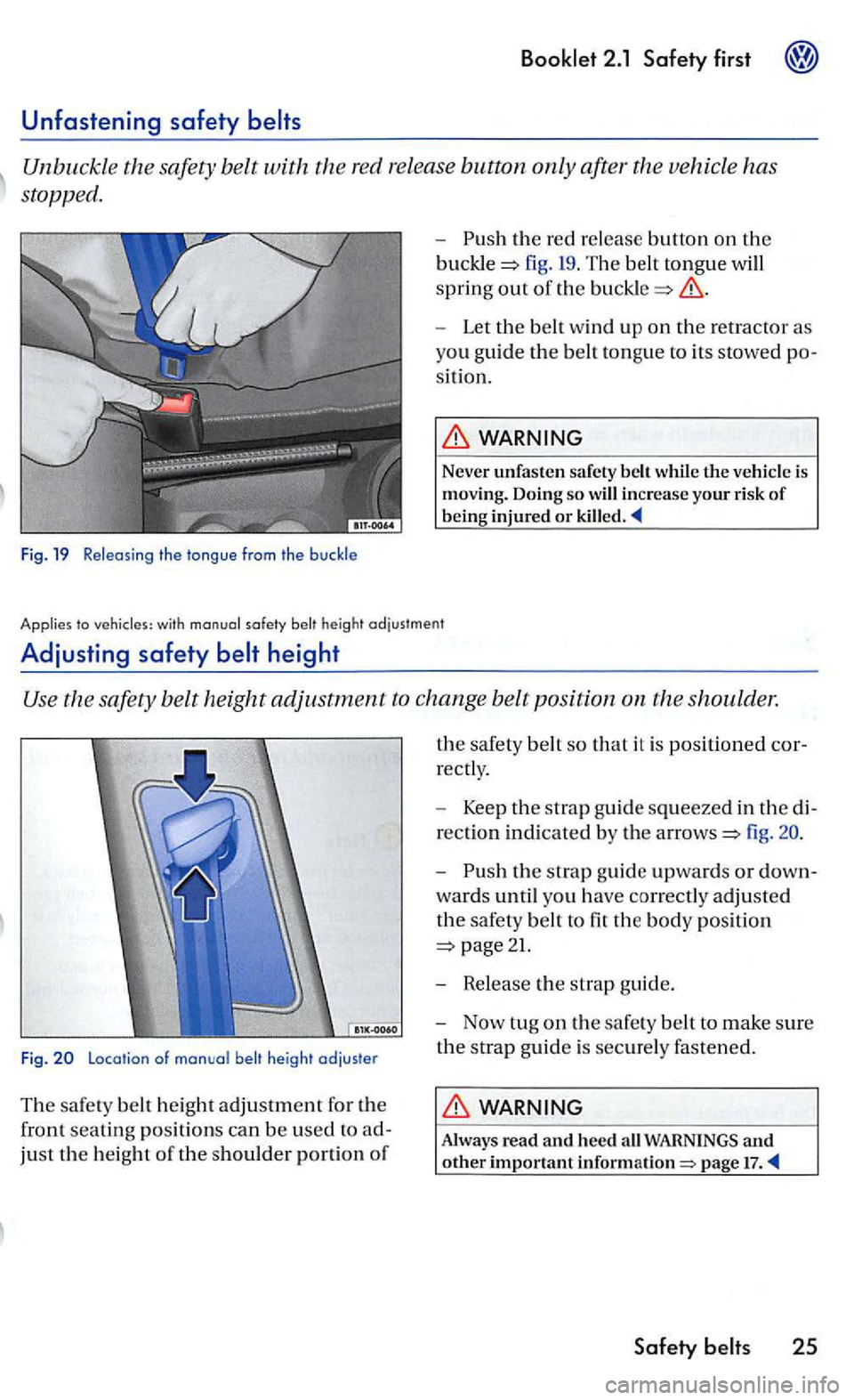
Unbuckle the safety belt with the red re lease button only after the vehicle has
stopp ed.
Fig. 19 Relea sing the tongue from the buckle
-the red re lease butto n on the
fig. 19 . The belt tongue will
s p ri
ng out of th e
WARNING
Never unfaste n safet y belt while the vehicle is
moving. Doing so will increase your risk of being injured or
to h eight adjustment
Adju sting safety
the safety belt height adjustm ent to ch ange belt position on th e shoulde r.
Fig. Location of manual belt height adjuster
The b e lt heig ht adjusunent for th e
fron t
seating pos it ion s ca n be used to ad
just the heig ht of th e should er porti on of
the safety belt so that i t is posit ioned cor
r
ectly .
-
Keep the s trap guid e squeeze d in the di
r
ection indicate d by th e fig.
-
WARNING
Always read and hee d WARNINGS and other important page 17.
Page 117 of 444
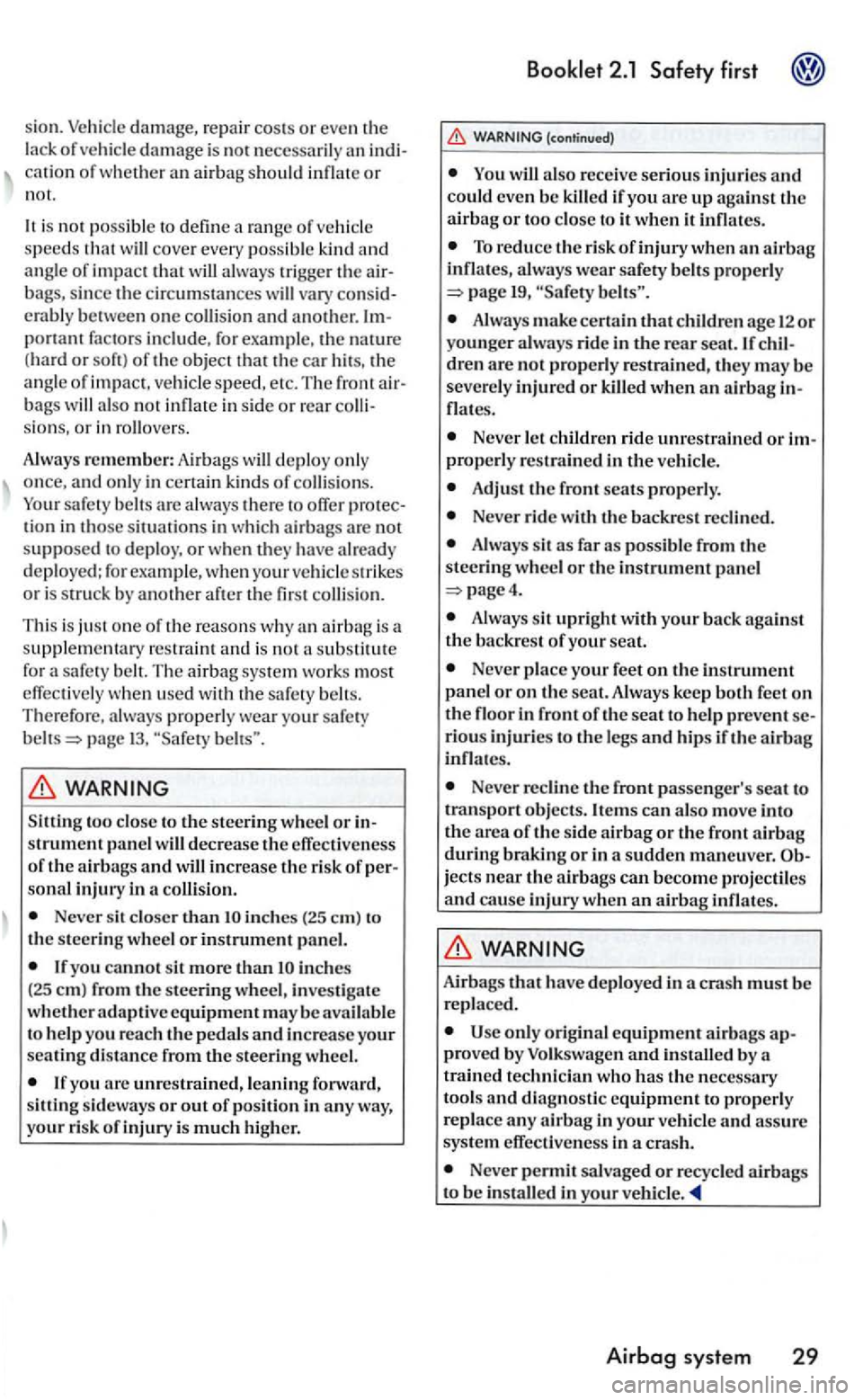
sion. d am age, repair co sts or eve n the
l ack of damage is no t an of w het her an airb ag s ho uld o r
not.
i s no t po ssible to define cove r every poss ibl e kind and an g le of impact that alway s tri gge r th e bags , s ince th e c ircumstan ces vary era b ly be tw ee n one po rt ant factors include , for examp le, the natur e
( hard or so ft) of th e objec t that the ca r hi ts, th e
angle of imp act, vehicle speed, etc. The front bag s als o no t in side or rear sio ns, orin rollove rs .
Always re m em ber: Airb ags
depl oy only
once, and only in certain kinds of collisions. safety b elts are always th ere to tion in th o se situ ations in w hi ch airb ags are not supposed t o dep loy . o r when they have already
d eployed; for exa mpl e, wh en yo ur
sub stitut e for safe ty bel t. The airba g syste m wor ks mo st
effectivel y w he n u sed with the sa fety belts. Therefore , always properly wear your sa fety
WARNING
S itting too clo se to the stee rin g wheel or strument pa n el will decrease the effec tiv en ess of the airbags and will increase the risk of sonal injury in a co llision.
Ne ver sit clo se r than in ch es (25 em ) to th e steering wheel or instrument panel.
If you cannot sit more than
first
(continued)
to it when it
To redu ce the risk of injury when an airbag inflates, always wear safety belts properly 19,
Always make certain that children age 12 or younge r always rid e in the rear seat. If dren are not properly restrained, they may be sever ely injured or killed when an airb ag flat es.
Never le t childr en ride unrestrained or
Adju st the front seats properly.
Never rid e w ith the backr est
Always sit as far as poss ible from the steerin g whee l or the instrument panel
Alway s sit upright with your back against the backrest of your seat.
Neve r place your feet on the in strument panel or on th e seat . Always keep both feet on the in front of the seat to help preven t rio us in juri es to the legs and hip s if the a irbag
infl ates.
Never reclin e the front passenger 's seat to transport objects. Item s can also move into the area of th e s ide alrbag or the front airbag during braking or in a sudden maneuver. jects b eco me projectiles and caus e injury when an airbag infl ates.
WARNING
Airbags that have deplo yed in a cra sh mus t b e replaced .
onl y o riginal equipment airbags proved by Volkswagen and Installed by a
trained technician who has th e necessary tool s and diagnostic equipment to properly replace any airbag in your
Never permit salvage d or recycled airba gs
to be installed in your vehic le.
Airbag system 29
Page 120 of 444
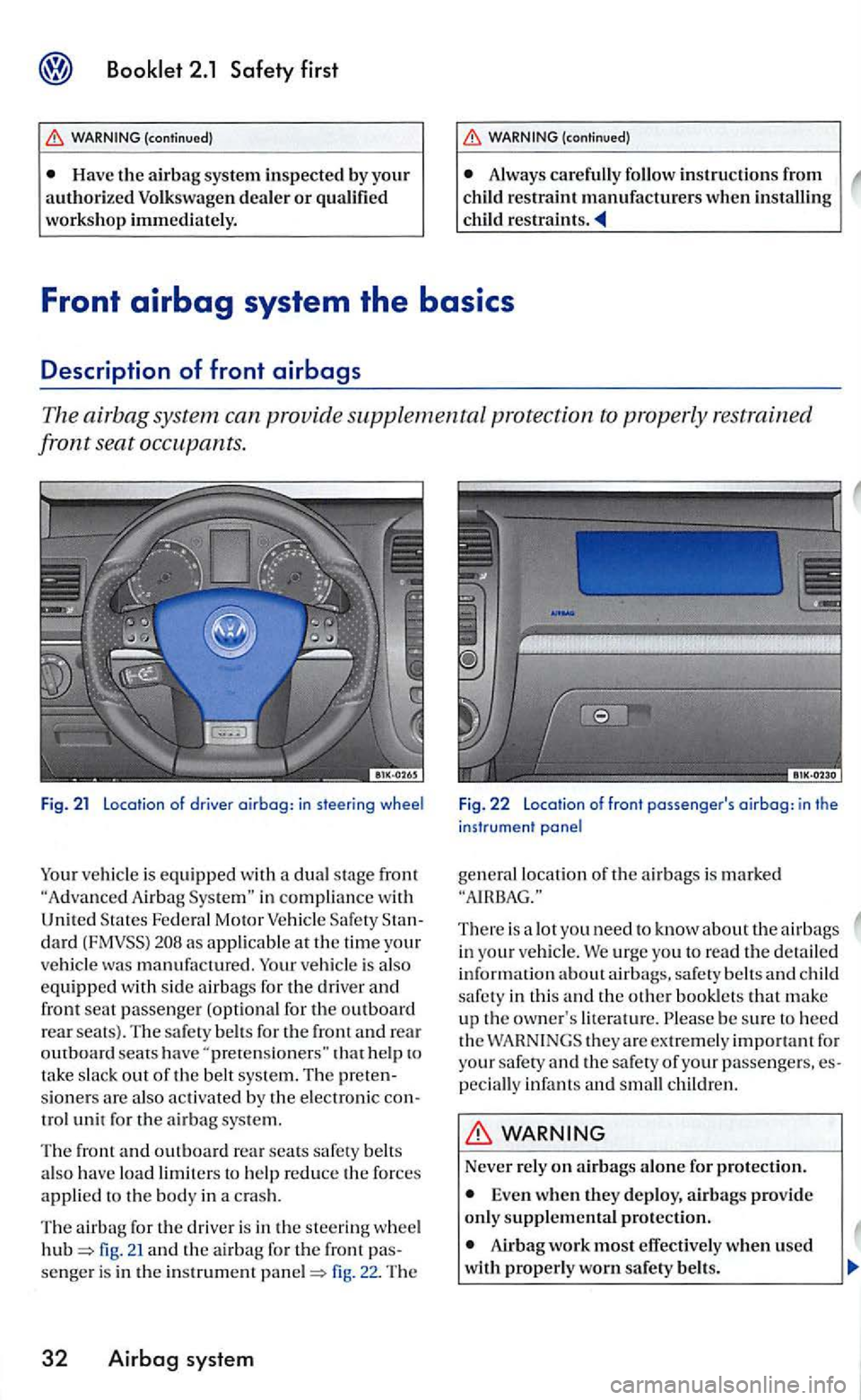
Have th e a irbag system inspected by you r authorize d Volkswagen deale r or qualified
workshop immediately. Always carefully follow instructions from
Fig. 21 Location of driver airbag: in steering wheel
ve hicl e is equipped with a dual s tage front A ir bag in compliance w ith
Unit ed Fede ra l Motor Veh icle dard as applicable at th e time your ve hicl e was manufa ctured . vehi cle is also equipped w ith sid e airbags for the driver and fron t se at passenge r (opt io nal for the outboard re a r seats). The sa fety belts for th e front and re a r outboard seats have ''pretensioners"
fig. 21 and th e ai rbag for the front fig. 22. The
32 Airbag system
F ig. 22 Location of front passenger's airbag: in the
instrument panel
gen era l lo ca tion of the a irba gs is marked
There is a lot you need to know about th e airbags in yo ur veh icle . We urg e you to read the detailed
information abo ut airb ags. safety belts and child
safe ty in thi s and the o th er bookle ts th at m ake
up the own er' s literature. be sur e to heed
th e th ey are extrem ely important for
your safet y and t h e s afety of yo ur passe nge rs, pecially infan ts and small c hildr en.
WARNING
Never rely on airb ags alone for protect ion.
Even when they deplo y, airbags provide only supplem ental protection.
Airbag work most effective ly w he n used
with properl y worn safet y belts.
Page 122 of 444
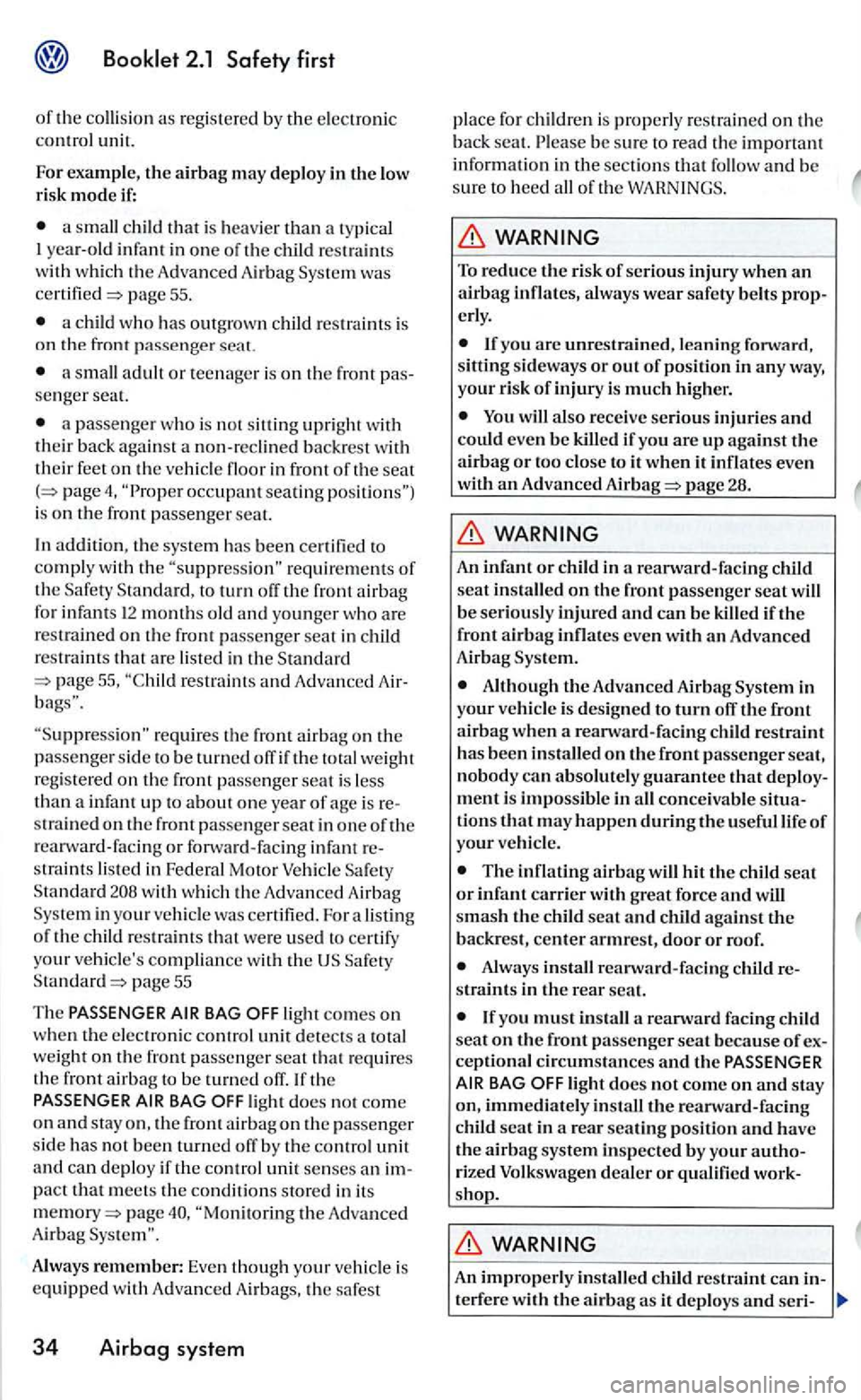
a small child that is heavier than a typica l
I ye ar-old infant in one o f th e child restraint s
w ith whi ch th e A dvan ced Airbag was page 55.
a child who has outgrown child res traints is
o n
a small adult or te enage r is on th e front se nger seat.
a passe nge r w ho is not sitting upright with
thei r back against a non -re clined backr est with
th eir feet on th e ve hicl e floor in front of the seat occupant seatin g is on t h e fr o nt passenger seat.
re quir em ent s of th e to turn off the fron t a irb ag
f o r infant s 12 months old and younger w ho are
re strained on the fro nt passenger seat in ch ild
restraint s that are liste d in the Standard re str aint s and Adva nce d
requires the front airb ag on th e passenge r sid e to be turned off if th e tota l weig ht
r eg is tered on th e front passe nger is less
th an a inf ant up to about one year of age is s tra ined on the front passe nger seat in one of the rea rward-faci ng or for wa rd-fa cin g inf ant str aint s listed in Fed eral Moto r Vehicle
page 55
The BAG
light does no t come o n and stay on . th e front airbag on the passen ge r
s id e has not been turned off by th e co ntrol u nit and can deploy if th e control unit se nses an pact that meets th e co nditio ns s tored in its page
Alwa ys remember: Even thoug h yo ur veh icle is equipp ed with Adva nced Airb ags, the sa fest
34 Airbag system
pla ce fo r childr en i s properl y restrained on th e back seat. b e sure to read the important
information in the sections tl1at follo w and be
sure to heed all of th e WARNINGS.
To reduce th e risk of serious injury when an airbag inflates , always wear safety belts erly .
You will also receive serious injuries and could even be killed if you are up against the airbag or too close to it when it infl ates eve n
with an Advance d Airbag
An infant or child in a rearward-facing child
seat installed on the fron t passenger seat will be seriously injure d and can be killed if th e
front airbag inflate s eve n with an Advanc ed
Airbag System.
Although
ment is impossibl e in all conce ivab le tions that may happen during th e usefu l lif e of your ve hicle.
The infl atin g airbag hit the child seat or infant ca rrier with great force and will
s m as h th e child seat and child against backres t, center armrest, door or roof.
straint s in the rear seat.
front passe nge r scat because of ceptional circumstances and the
sh op.
terfer e with the airbag as it deploys and seri -
Page 128 of 444
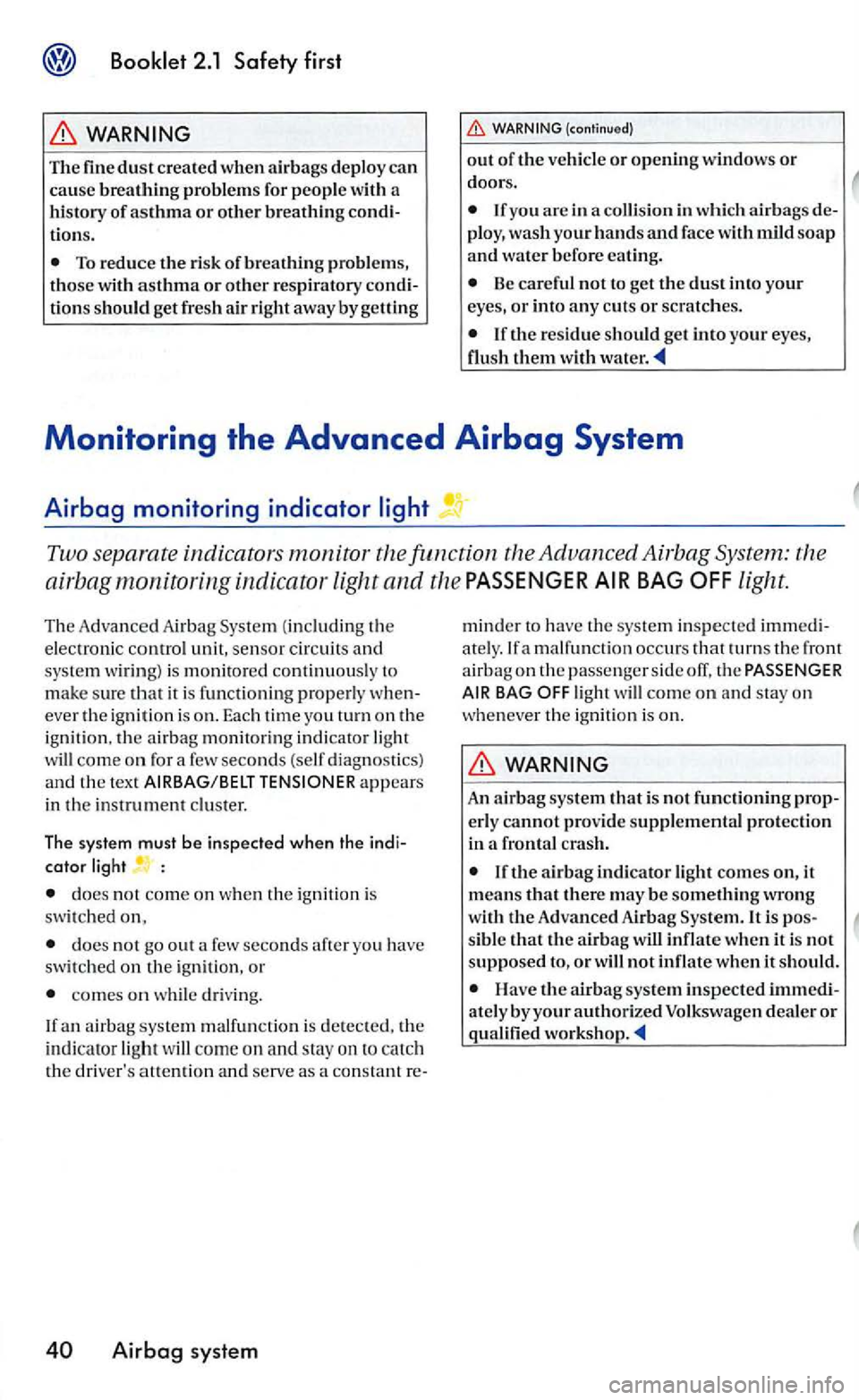
WARNING
The fine dust created when airbags deploy can cause breathing proble m s for people w ith a history of asthma or other breathing condi
tions.
To reduce the risk of breathing problems,
those with asthma or other respiratory condi
tions should get fresh air right away by getting
(cont;nu od)
out of the vehicle or opening w indows or doors.
If yo u are in a co llision in which airb ags de
ploy, wash your h ands and face with mild soap and water before eating.
Be carefu l not to get the dust into your eyes, or into any cut s or scratc hes.
If the residue should get into your eye s,
flush them with water.
Two separate indicators monitor the function the Advanced Airbag System: the
airbag monitoring indicator light
and the PASSENGER light.
The A dva nced Airba g Sys te m (in cludin g th e electronic control unit, senso r c ir c uits and sys te m wiring) is m onit ore d continuously to mak e sure tha t it is fun cti o nin g properl y wheneve r the ignition is o n. Each time you turn on th e
i gnition. the a irba g monitoring indicator light
w ill co me o n for a fe w second s (se lf di ag nostics) and th e text AIRBAG/BELT appears
in the in strument clu ster.
The sys tem must be inspected when the indi
cator light
does not come on when th e ignition is
switc h ed on,
doe s not go out a few seconds after you have
s wit ched on the ignition, or
comes o n while driving.
If an airbag system malfu nc tion is de te cte d , th e
indicator light will come on and sta y on to catch
th e dri ver's attention and se rve as a con stant re-
fa malfunction occurs that turn s th e front airbag on th e passe nge r side th e PASSENGER AIR BAG
WARNING
An airbag system that is no t functioning prop
erly cannot provide suppl emental protection
in a frontal crash.
not inflat e when it should.
Page 134 of 444
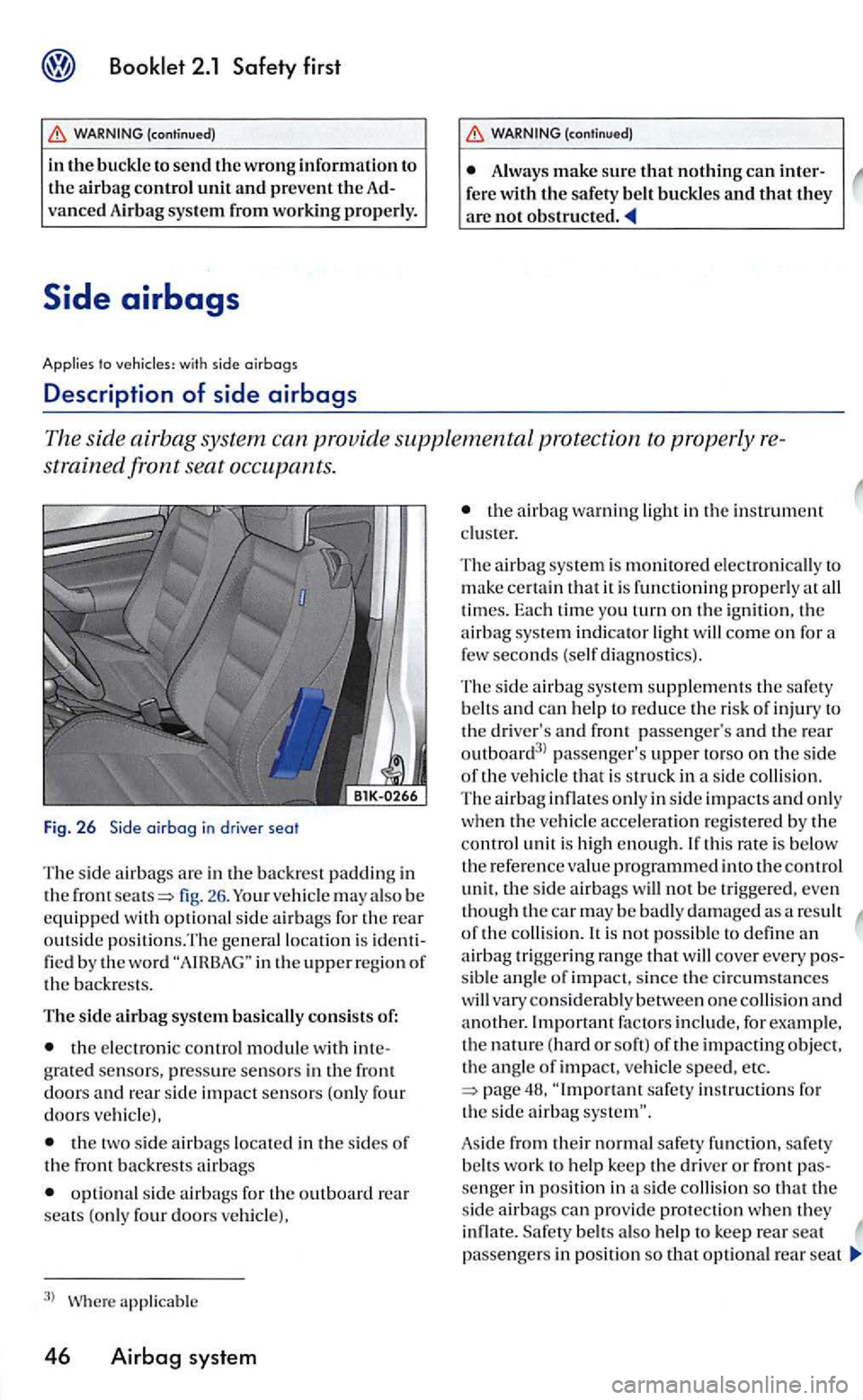
to vehic les: with side airbags
Description of side airbags
Always make sure that nothing can inter-fe re with the safety be lt buckles and that they are not
The sid e airbag system ca n provid e supplemental protection to properly
strain ed fron t seat occupant s.
Fig. 26 a irbag in drive r seat
The side air b ag s are in the backr est p addin g in the fig. 26 . ve hicl e m ay als o b e
equipped w ith optiona l sid e ai r bags for the re a r
outs id e po siti ons.Th e ge nera l lo cat io n is in the upper regio n of the backrests .
The side airbag system basically consis ts of:
the e lectroni c co ntro l module with grated sensors, pre ssure sen so rs in the front doors and re a r s ide impact sensors (only four doors ve hicle).
the two side airbags locate d in the s ides of the fro nt backre sts a ir ba gs
opti ona l s id e a irbags for the outboard rear seats (only four door s ve hicle).
3) W here ap plicabl e
46 Airbag system
the airbag warning light in the in strument clu ster.
The airb ag syste m is monitore d electroni cally to make certain that it is fun ctioning properly at all times. Ea ch time you turn on th e ig nition, the
a irba g syste m indi cator light will come on fo r a
few s e conds (self diagnostic s).
Th e side
airbag s ys te m supplements the s afet y
b elt s and can help to reduce the ris k of injury to the dri ver's and passenge r's and the rear
outboard3> passen ge r's upper to rs o on the s ide
o f the ve hicl e that is st ruck in a s ide colli sio n. The a irb ag infl ates onl y in sid e impacts and o nl y
w he n th e ve hicle accele rati on r egis te re d by the
co ntrol unit is hi gh enough. If thi s rate is be lo w
th e re fe re nce valu e progr ammed into the control unit. the s ide airb ags will not be tri gge re d , ev en
th oug h the car m ay be bad ly da m ag ed a s a re su lt
o f the c ollis ion .
sib le angle of impa c t, s ince th e c ircumsta nce s
will v ary consid era bly betw een one collisio n and ano ther. Important fac tor s includ e, Fo r e xample, the nature (hard or soft) oft h e impacting o bject, the ang le of impact, ve hicl e speed, e tc . s afe ty in stru ctions fo r the sid e a irbag
Aside from their normal safety function, sa fe ty
b elt s work to he lp keep the driver or front se n ge r in po sition in sid e co llision so that the
s ide airb ags c an pro vid e pro tection whe n th ey
inflate. Safety belt s als o help to keep rear seat
passenge rs in pos ition so tha t opti onal seat